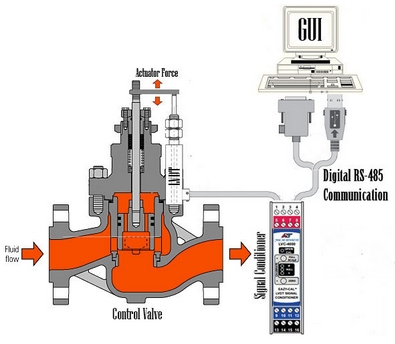 |
| October 22, 2013 | Volume 09 Issue 40 |
Designfax weekly eMagazine
Archives
Partners
Manufacturing Center
Product Spotlight
Modern Applications News
Metalworking Ideas For
Today's Job Shops
Tooling and Production
Strategies for large
metalworking plants
Engineer's Toolbox:
Why more sensor users are using digital output
When sensor accuracy is critical and networked communications are desirable, digital communications serve as a more reliable and cost-effective alternative to analog output.
By Lee Hudson, Applications Engineer, Macro Sensors

When using a sensor like a linear variable differential transformer (LVDT) to monitor operating parameters such as movement and position, digital communications offer the highest accuracy because the output sensor signal is not easily degraded.
Excessive noise generated from environments such as oil fields and turbines can cause incorrect results and non-linearity errors as analog systems become more complex.
With greater immunity to noise, digital systems have a greater capacity to control errors and provide a complete signal from an LVDT and other sensors into computer software and other network programs.
In a recent survey conducted by Macro Sensors through Linked In groups and its own customer database, many users of digital communications attest to increased resolution and tighter control results from faster response times that reduced process variability.
In networked communications, digital communications allow for daisy chaining multiple signal conditioners on one bus line, reducing wiring costs. One survey respondent touted numerous fieldbus benefits, including reduced I/O cards and wiring, footprint, and weight as well as reduced installation labor.
With an RS 485 digital output, longer cables up to 4,000 ft can be used from the sensor to the data acquisition system, with several integrated along one cable instead of one sensor per cable. Longer cables enable the placement of LVDTs or sensors in harsh conditions with electronics securely located in nonvolatile environments.
How to go digital
Digital output can be derived from any standard sensor using a signal conditioner designed to provide an RS-485 digital signal. For example, Macro Sensors EAZY-CAL LVC-4000 LVDT / RVDT Signal Conditioner interfaces with a wide range of AC LVDTs, RVDTs, and VR half-bridges and offers customers the option of using either a 4-20 ma analog signal or a digital signal RS-485. Both outputs can be used for different requirements or either, based on user preferences. With the use of the RS-485 port, a host computer is able to retrieve measurement data, receive operational status, perform remote calibration, and perform hot-swap reconfiguration.
Synchronization to other signal conditioners is accomplished by a daisy-chain connection to a synchronization bus. One unit will assume the Master function based on DIP switch priority setting. If a fault should occur, the next highest priority unit will take over as Master.
For more information on Macro Sensors' LVC-4000 LVDT/RVDT Signal Conditioner, visit www.macrosensors.com/LVC_4000.html or contact us at positionsensors@macrosensors.com.
Published October 2013
Rate this article
View our terms of use and privacy policy
